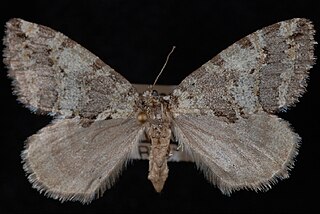Hydriomena macdunnoughi is a species of moth in the family Geometridae. It was described by Louis W. Swett in 1918 and is found in North America, where it has been recorded from Yukon Territory to western Alberta and Colorado.
Hydriomena magnificata, the magnificent highflier, is a species of geometrid moth in the family Geometridae. It is found in North America.

Hydriomena perfracta, the shattered hydriomena, is a species of geometrid moth in the family Geometridae. It is found in North America.
Hydriomena crokeri is a species of geometrid moth in the family Geometridae. It is found in North America.

Hydriomena exculpata is a species of moth in the family Geometridae first described by William Barnes and James Halliday McDunnough in 1917. It is found in North America.

Hydriomena irata is a species of geometrid moth in the family Geometridae. It is found in North America.

Hydriomena expurgata is a species of moth in the family Geometridae first described by William Barnes and James Halliday McDunnough in 1918. It is found in North America.

Hydriomena albifasciata is a species of geometrid moth in the family Geometridae. It is found in North America.
Hydriomena furculoides is a species of moth in the family Geometridae first described by William Barnes and James Halliday McDunnough in 1917. It is found in North America.
Hydriomena pluviata, the sharp green hydriomena moth, is a species of geometrid moth in the family Geometridae. It is found in North America.
Hydriomena quinquefasciata is a species of geometrid moth in the family Geometridae. It is found in North America.

Hydriomena renunciata, the renounced hydriomena, is a species of geometrid moth in the family Geometridae. It is found in North America.

Hydriomena californiata is a species of geometrid moth in the family Geometridae. It is found in North America.
Hydriomena mississippiensis is a species of geometrid moth in the family Geometridae. It is found in North America.
Hydriomena costipunctata is a species of moth in the family Geometridae first described by William Barnes and James Halliday McDunnough in 1912. It is found in North America.
Hydriomena nevadae is a species of moth in the family Geometridae first described by William Barnes and James Halliday McDunnough in 1917. It is found in North America.

Hydriomena marinata is a species of moth in the family Geometridae first described by William Barnes and James Halliday McDunnough in 1917. It is found in North America.
Hydriomena bistriolata is a species of geometrid moth in the family Geometridae. It is found in North America.

Hydriomena edenata is a species of geometrid moth in the family Geometridae. It is found in North America.

Hydriomena nubilofasciata, the oak winter highflier, is a species of geometrid moth in the family Geometridae. It is found in North America.










